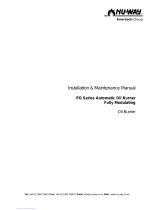
750-297
Profire E/LNE Series Manual 1-5
Introduction
1.6.5 — Oil Metering
Fuel oil under nominal pressure in the circulating loop flows to the adjustable positive displacement (volumetric
metering unit). Oil metering is accomplished by changing the piston stroke by means of an eccentric shaft and pin
assembly. The pistons reciprocate in a rotor assembly, turning in a hardened steel sleeve having oil inlet and discharge
slots. During each revolution the pistons go through the following cycle:
1. Inlet Cycle. The piston is at the bottom dead center position. At this position, the cavity between the top of the
piston and the outside diameter of the rotor fills with oil.
2. Discharge Cycle. (180º from inlet cycle) The piston is at the top dead center position. At this position, the oil is
forced out of the discharge port to the nozzle. The piston stroke length is determined by the position of the eccentric
shaft and plate. The piston adjustment plate is positioned by an adjustable eccentric shaft. The eccentric shaft is
positioned by the modulator through adjustable linkage. Counterclockwise rotation of the eccentric shaft increases
the piston stroke (more oil delivered to nozzle); clockwise rotation decreases the amount of oil delivered. When the
eccentric shaft is stationary, at any position, the stroke of the pistons remains constant delivering a constant volume
of oil regardless of viscosity.
1.6.6 — Separate Compressor Module
EL and ELG burners have a burner mounted oil metering unit and a separate compressor module. The system functions
as follows:
Air is supplied by a positive displacement rotary vane compressor. This provides a constant volume of atomizing air
regardless of pressure. The compressor module includes motor, air-oil reservoir tank, air filter, and lube oil cooling coil.
Air enters the compressor through the filter. The air flows from the compressor into the air-oil separating and reservoir
tank. Filtering material and baffles separate the lube oil from the compressed air. The tank air pressure forces
lubricating oil from the tank to the compressor to lubricate bearings and vanes. A sight glass indicates the level of
lubricating oil in the air/oil reservoir. Lubricating oil must be visible in the gauge glass at all times. Air compression
heat is absorbed in part by the flow of lube oil, creating a hot oil mist. The air/oil mist is cooled by a coil assembly.
Lube oil is also cooled before entering the compressor.
Fuel is delivered to the positive displacement metering pump at 10 to 15 psi. Metered oil is delivered to the common
port of a 3-way solenoid valve for transfer to the burner nozzle through the normally closed port or back to the storage
tank through the normally open port. During pre- and post-purge, metered oil is returned to the tank. During normal
firing, all metered oil is delivered to the nozzle. For the description of typical fuel oil piping installations, see Chapter 2.
Air enters a rotary vane compressor through an air cleaner where it is compressed to atomizing pressure. Air flows from
the compressor to an air/oil tank which serves the multiple purpose of dampening air pulsation, lube oil mist recovery,
lube oil and atomizing air storage. The compressor rotor is cooled and lubricated continuously by oil under pressure
from the air/oil tank. Oil vapor is extracted by a mist eliminator in the upper section of the tank. Atomizing air from the
upper tank section is delivered to the nozzle at a constant volume. Air pressure increases as the burner firing rate
increases. Atomizing pressure may be adjusted by the needle valve located on the air-oil pump. The valve allows air to
be bled from the tank to the compressor inlet. Delivery rate of the fuel oil metering pump is controlled by the
modulating motor through adjustable linkage.





















